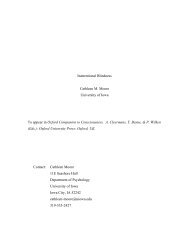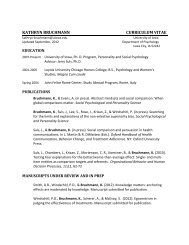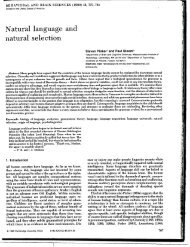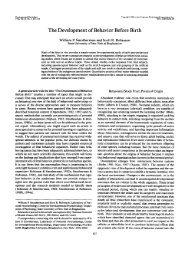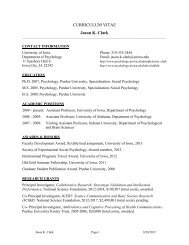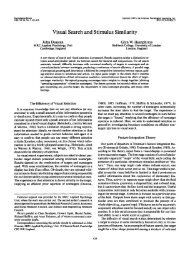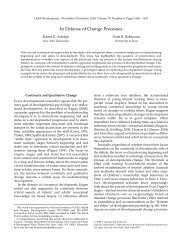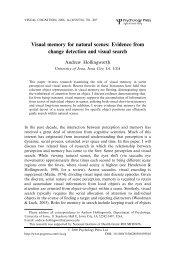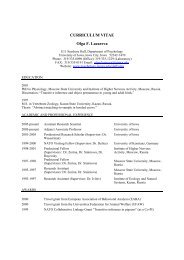282C. Ouellet, H. Cohen / Journal of Neurolinguistics 12 (1999) 271±288However, despite some positive changes in the discrete elements of speech (e.g.vowel <strong>and</strong> consonant production), the improvement remains rather weak for the®rst 2 post-implant years <strong>and</strong> gradually reaches 40% after 3.5 years of implantexperience. Open-set speech intelligibility is the most dicult measure of speechproduction to master [64]. Mondain et al. [48], however, showed that the averagespeech intelligibility for prelingually deaf children, after 4 years of experience withthe implanted device, reached 74% correct. Te et al. [79] found a di€erent patternof improvement in prelingually deaf children, with immediate correct speechscores as early as the ®rst day of implant use. <strong>Speech</strong> production then improvedquickly for the ®rst 4 months, with rapid improvement from day 1 to days 30 <strong>and</strong>120, providing evidence for immediate gains in speech production with cochlearimplants. Vowel production was the easiest task to master <strong>and</strong> word-patternrecognition <strong>and</strong> consonant voicing tasks were of intermediate diculty. Thehardest skills to achieve were consonant placing <strong>and</strong> manner of consonantproduction. <strong>Speech</strong> production may reach a plateau by 1.5 years <strong>following</strong>implantation with single-electrode devices, but no plateau has yet been observedwith the Nucleus multichannel device after 2 or more years of use [45].Children who gain some speech intelligibility, regardless of their degree ofimprovement, do not show any degradation in their speech production abilitiesafter switching o€ their cochlear implant for several hours. No di€erence in vowelheight, vowel place, initial consonant place, initial consonant voicing, or ®nalconsonant voicing was found between the device-on <strong>and</strong> -o€ conditions in theseimplanted children. When the device was turned on, there was sometimes atendency for nasalization of vowels <strong>and</strong> inappropriate aspiration of consonants,suggesting an e€ort to increase proprioceptive feedback [83]. After at least 2 yearsof implant use, prelingually deaf children can produce consonants varying on thefeature of place of articulation with greater accuracy than those that contrast onvoicing, duration <strong>and</strong> frication. Moreover, implanted subjects who were likely todiscriminate place of articulation, nasality <strong>and</strong> voicing features in audition-onlyconditions also produced these features more correctly [82]. However, goodperceivers are not always good producers [60].Finally, a case study reported by Robinshaw [66] showed signi®cantimprovements in the ability to imitate prosody <strong>and</strong> speech sounds <strong>following</strong> theimplantation procedure. In this particular case, speech production occurredshortly before word comprehension <strong>and</strong> the patient followed a pattern of<strong>development</strong> predicted by Ling 1 [35,36]. The pattern <strong>and</strong> timing of spoken wordacquisition was delayed but nevertheless similar to that of normal-hearing controlsof the same hearing age. Soon after the switch-on, the subject's phonetic <strong>and</strong>1 This order, proposed by Ling [35,36], suggests that speech <strong>development</strong> in prelingually deaf childrenwith cochlear implants follows a succession of seven stages, from lower to higher skills: (1) vocalizationfreely <strong>and</strong> on dem<strong>and</strong>, (2) suprasegmental patterns, (3) all vowels <strong>and</strong> diphthongs with voice control,(4) production of consonants by manner of articulation with all vowels, (5) consonants by place withmost vowels, (6) consonants by voicing with most vowels <strong>and</strong> (7) initial <strong>and</strong> ®nal blends (intelligiblespeech <strong>and</strong> natural voice patterns), with this ®nal level reached after 2 yr of implant experience.
C. Ouellet, H. Cohen / Journal of Neurolinguistics 12 (1999) 271±288 283phonological skills developed <strong>and</strong> phonetic/articulatory skills emerged beforeextending to everyday speech. The phonological level followed the phonetic one.This is in agreement with Miller [42], who found that the impairment caused byprelingual deafness may be restricted to the phonological aspects of <strong>language</strong>.7. Psychosocial impactsTait [77] reported an increase in eye contact <strong>and</strong> vocal turn-taking, as well as adecrease in gesture in 10 children after 12 months of cochlear implant experience.This enhancement of attention <strong>and</strong> involvement apparently permitted better verbalcommunication. Tait <strong>and</strong> Lutman [78] also found a propensity towards a vocal/auditory communication style in implantees. However, despite these changes incommunication modality, implanted children may continue to use signs incombination with vocalizations to communicate [62].Cochlear implants can also in¯uence the social behavior <strong>and</strong> social competenceof hearing-impaired people, who may lack peer acceptance <strong>and</strong> have lessdeveloped social abilities. Although some data suggest that young implantees maysometimes remain immature in their social interactions with hearing peers [31],other results show that cochlear implants improve interpersonal communicationskills <strong>and</strong> social con®dence <strong>and</strong> also reduce the user's social anxiety [26]. Severalpositive impacts of cochlear implants on the behavior of deaf children, whofrequently have behavior problems <strong>and</strong> are often impulsive <strong>and</strong> rigid [69], havebeen noted [13,40]. These improvements, however, may not always be maintainedover time <strong>and</strong> systematic investigations are still needed [62]. Good performers withcochlear implants will still encounter some linguistic diculties a€ecting theirinterpersonal interactions [46], despite changes in their communication mode.Cochlear implantation also has varied in¯uences on how parents communicatewith their implanted children. Six months after the operation, some mothers mayno longer use signs with their implanted child ([62], but see [31]). No matter how,cochlear implants do a€ect communication practices <strong>and</strong> not alwayssystematically. Nevertheless, these implants favor a variety of communicationstrategies <strong>and</strong> thus an enhanced mutual underst<strong>and</strong>ing. However, they have notbeen found to be e€ective in reducing parental anxiety. Parenting stress does notnecessarily decrease postoperatively Ð it may even increase. This may be due tounrealized expectations, the necessity of parental involvement in auralrehabilitation <strong>and</strong> restrictions in the pursuit of the parent's personal activities [63].8. RehabilitationSupport from home <strong>and</strong> school, training, (re)habilitation <strong>and</strong> education areessential factors that determine linguistic improvement [11] <strong>and</strong> permit theachievement of adequate phonetic <strong>and</strong> phonological competencies. Animplantation should be performed only if the cochlear implant center can o€er



